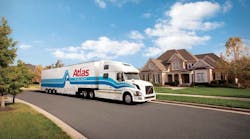Although not many have drawn the connection, the collapse of the 35W bridge in Minneapolis and the political battle over congestion fees for vehicle access in New York City are two sides of the same story. Traffic growth far exceeds our current will to pay for its consequences.
As Fleet Owner pointed out two years ago in our “Roads to Hell” series, America has been seriously under-funding maintenance and repair for our highway infrastructure for some time. Part of the problem has been escalating construction costs. Political infighting over how available funds are spent or diverted has also contributed to the dangerous deferment of necessary repairs. But the increase in vehicle use — including significant growth in truck traffic — has also exceeded original design projections and accelerated wear on our roads and bridges, wear we haven't allocated funds to address.
No one knows yet the exact cause of the 35W bridge's catastrophic failure, but we do know that structural problems related to wear had been identified as needing eventual attention, problems almost certainly related to the large volume of traffic that relied on that bridge to get across the Mississippi River. As one civil engineer explained it in a news report, every vehicle crossing a bridge compresses the structure, and the design life of the structure is measured in the number of those cycles it experiences.
When the bridge opened in 1967, it had four lanes and was expected to carry 66,000 vehicles a day, according to Minn. DOT projections. In 1988 it was reconfigured to eight lanes in response to growing congestion, and when it collapsed the daily traffic count was put at 140,000 vehicles. Fatigue cracks and other “structural deficiencies” had been documented as early as 1990, though none were considered serious enough to require urgent attention, and the bridge wasn't scheduled for replacement or major refurbishment until 2020.
The 35W bridge collapse demanded much public and media attention because it involved fatalities and a long-term significant increase in congestion on alternative roads and river crossings in the Twin Cities. And given its high profile, money will be found to quickly replace the span.
But in most cases, the ill effects of heavy traffic volume grow slowly without notice until one day people decide conditions have become intolerable. The questions then become how to address the issue and how to pay for those solutions. New York's mayor believes he has the answer to both question — charge a congestion fee to all vehicles entering the most clogged city streets.
No one really knows if this plan will work without dire economic consequences for the area's businesses, but it looks like we're going to get a chance to find out since the plan has received a promise of funds from the Dept. of Transportation. All details beyond the concept of a fee are up in the air, though I say it's a sure bet that trucks will pay more than cars.
But whether it's a fatal bridge failure or an unproven game of economic roulette, we're just beginning to pay the price for our wishful thinking that congestion problems would just evaporate if we ignored them long enough. Open up your wallets.
E-mail: [email protected]
Web site: fleetowner.com


